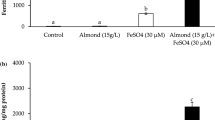Abstract
Background: Relatively little work has been done on the absorption of trace elements in the mammalian small intestine. Recently, studies have demonstrated that a molybdenum/ascorbic acid complex has shown some promise as a potentially orally administered insulin-mimetic agent. However, the transport mechanism of the molybdenum/ascorbic acid complex is unknown. In this study we examine some aspects of the movement of the complex across the intestinal wall using measurements of elemental molybdenum as an indicator because it is not possible to measure the complex directly.
Methods: Everted rat small intestine sacs were used to determine some aspects of the transport of the complex across the intestine. Intestinal sacs from five rats were incubated in a medium containing 1 g/L of the molybdenum complex. Sacs from a further five rats had 1 mmol/L of 2,4-dinitrophenol, a known inhibitor of oxidative phosphorylation, added to the incubation medium. In a second experiment, everted sacs from five rats were also incubated in media containing one of six concentrations of the molybdenum complex (0.5, 1, 2, 4, 8 or 10 g/L).
Results: There was no significant difference between transport rates of groups with or without 2,4-dinitrophenol in the incubation medium, suggesting that the predominant mechanism of molybdenum transport is energy-independent. There was a significant positive, linear increase in the transport rate with increasing concentration of the molybdenum complex.
Conclusion: These data suggest that the predominant mechanism of this molybdenum/ascorbic acid complex transport in the small intestine is non-saturable and therefore not protein-mediated.




Similar content being viewed by others
References
Thompson KH, Turnland JR. Kinetic model of molybdenum metabolism from dual stable isotope excretion in men consuming a low molybdenum diet. J Nutr 1996; 126: 963–72
Rajagopalan KV. Molybdenum: an essential trace element. Nutr Rev 1987; 45 (11): 321–8
Conrad ME, Umbreit JN, Moore EG. A role for mucin in the absorption of inorganic iron and other metal cations. Gastroenterology 1991; 100: 129–36
Conrad ME, Umbreit JN, Moore EG, et al. Separate pathways for cellular uptake of ferric and ferrous ion. Am J Physiol Gastrointestinal Liver Physiol 2000; 279: G767–74
Nelson N. Metal ion transporters and homeostasis. EMBO J 1999; 18 (16): 4361–71
Carden CJ, Mason J. Molybdate and tungstate transfer by rat ileum, competitive inhibition by sulphate. Biochim Biophys Acta 1976; 455: 937–46
Gunshin H, MacKenzie B, Berger UV, et al. Cloning and characterization of a mammalian proton-coupled metal ion transporter. Nature 1998; 388: 482–8
Menard MP, Cousins RJ. Zinc transport by brush border membrane vesicles from rat intestine. J Nutr 1983; 113: 1434–42
Rolfs A, Hediger MA. Metal ion transporters in mammals: structure, function and biological implications. J Physiol 1999; 518 (1): 1–12
Knopfel M, Schulthess G, Funk F, et al. Characterization of an integral protein of the brush border membrane mediating the transport of divalent metal ions. Biophys J 2000; 79: 874–84
Dowdle EB, Schacter D, Schenker H. Active transport of Fe59 by everted segments of rat duodenum. Am J Physiol 1960; 198 (3): 609–13
Davenport HW. Physiology of the digestive tract: an introductory textbook. Chicago: Year Book Medical Publishers, 1982
Randall DJ, Buggren W, French K. Eckert animal physiology: mechanisms and adaptations. 4th ed. New York: WH Freeman and Company, 2001
MacDonald K, Bailey J, MacRory C, et al. A newly synthesised molybdenum/ascorbic acid complex alleviates some effects of cardiomyopathy in streptozocin-induced diabetic rats. Drugs R D 2006; 7: 33–42
Lord SJ, Epstein NA, Paddock RL, et al. Synthesis, characterization, and biological relevance of hydroxypyrone and hydroxypyridinone complexes of molybdenum. Can J Chem 1999; 77: 1249–61
Acknowledgements
The authors would like to thank Ms Kelly Crossman for her ability to maintain a rat colony in excellent health. Funding for this study was provided by the New Brunswick Heart and Stroke Foundation, the Natural Sciences and Engineering Research Council of Canada, the Canadian Foundation for Innovation and a research grant from Mount Allison University.
The authors have no financial interests or other conflicts of interest relevant to the content of this study.
Author information
Authors and Affiliations
Corresponding author
Rights and permissions
About this article
Cite this article
Russell, M.S., Bailey, J., Duffy, S.J. et al. Gut Transport of a Molybdenum/Ascorbic Acid Complex. Drugs R D 7, 111–117 (2006). https://doi.org/10.2165/00126839-200607020-00005
Published:
Issue Date:
DOI: https://doi.org/10.2165/00126839-200607020-00005




